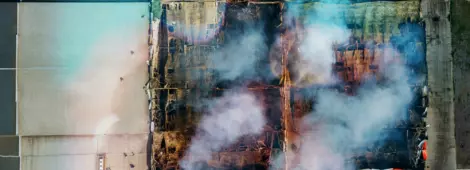
When Alarm Bells Ring: How Forensic Fire Investigators Uncover Arson Fraud
by Mike Wisekal, MSc, AAs, CFI, FIT, MIFireE
Arson fraud – a type of insurance fraud involving the willful and malicious burning of property for the purpose of collecting insurance money – continues to be a significant issue for the insurance industry. Recognition of warning signs and prompt action are key to identifying arson fraud and obtaining the evidence needed for repudiation of fraudulent insurance claims.
Since the success of the repudiation will rest on the weight of the presented evidence, preserving and recording a potential arson scene is paramount. A forensic investigator with expertise in interpreting fire scenes can add to the weight of evidence when pursuing a repudiation against arson fraud.
Forensic fire investigators can respond quickly to the scene to record and recover any potential supportive evidence. They use their keen eye to observe indicators of arson fraud which are then communicated to the insurer, claims handler or loss adjuster. Investigators typically look at the following areas for indicators of arson fraud: property, combustion, circumstances and fire protection.
Property
An astute forensic investigator first looks for indicators that support the intention of fire spread. This might include signs of fire doors being held open, deliberate holes made in walls, ceilings and floors, evidence of forced entry, or indications that emergency service responders were delayed due to deliberate obstruction of access by the culprit.
Combustion
A forensic analysis of the scene must also consider the materials involved in the fire as well as any signs of unusual rapid-fire development or unnatural fire spread. The presence of ignitable liquids or incendiary devices, items piled up to assist the spread of fire and fires originating in locations without an accidental ignition source can all be supportive indicators of arson insurance fraud.
Circumstances
Suspicious circumstances and claimant behaviors can raise red flags during a fire insurance investigation as well. The forensic investigator may find that the claimant insisted on a fast settlement. Or the insured may have asked the insurer hypothetical questions about what could happen if a fire were to occur or a claim was made.
Additionally, there may be indications that valuable items had been removed before the fire, possibly replaced with lesser value items and that fire-damaged remains do not match items claimed as lost in the fire. The forensic investigator may also discover that the fire was concentrated on financial documents or occurred during a renovation or property sale. All of these instances can point to potential arson fraud.
Fire Protection
Fire protection systems provide early warning to occupants should a fire occur. However, the deliberate deactivation of fire detection and security systems, disabling of fixed firefighting systems, removal of portable fire extinguishers or disabling of CCTV cameras can be clear indicators of fraudulent behaviour.
Responding to Arson Fraud
While an insurer has the right to protect themselves against arson fraud and uphold the policy conditions against fraudulent claims, the insurer is also legally bound to bring forward the case against the insured and present proof of the fraud. Arson insurance fraud stands a chance to be proven when the claimant’s engagement has been found to be dishonest and it is determined that their intention was to gain from or cause loss to another.
When those alarm bells do sound, promptly involving a forensic fire investigator can greatly increase the prospects for a successful determination of arson fraud. Jensen Hughes, with our rapid response and technical excellence, is well equipped to offer first-rate forensic solutions in the event of a suspected arson fire loss. To instruct one of our forensic fire investigators, contact us at Instructus.uk@jensenhughes.com.

Mike has worked in the fire industry since 1997, serving nearly 18 years in the Fire Service. His fire service career included fulfilling various roles from operational firefighter to Incident Commander. Part of his operational training…












